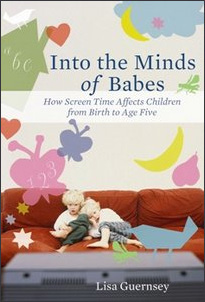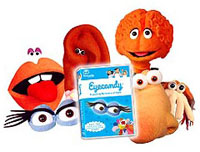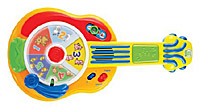Tuesday, February 26th, 2008
In 2004, the American Academy of Pediatrics announced that all screen-based viewing for children ages two or under should be avoided completely. At the same time dozens of “brain boosting” DVDs, videos, and interactive products hit the marketplace with claims of being beneficial to child’s cognitive development. Many parents are torn. What is the right thing to do for their child?
 In Lisa Guernsey‘s book, Into the Minds of Babes – How Screen Time Affects Children From Birth to Age Five, she explores many of the media claims about screen time and young children. She digs deep into the world of child research and not only investigates which research is credible and which is not, but she also makes the material accessible for the everyday parent along the way.
In Lisa Guernsey‘s book, Into the Minds of Babes – How Screen Time Affects Children From Birth to Age Five, she explores many of the media claims about screen time and young children. She digs deep into the world of child research and not only investigates which research is credible and which is not, but she also makes the material accessible for the everyday parent along the way.
After reading her book I’ve had the opportunity to see Lisa speak a couple of times at conferences that focus on children. At a recent conference I spoke with Lisa about her book.
Scott Traylor: Lisa, let me start by asking you a little bit about yourself – who you are and how you came to writing your book.
Lisa Guernsey: I’m an education technology reporter. I was writing for the New York Times Circuits section about online media and other technologies, then I had kids. The story I tell in the book is that I had a colicky baby and I couldn’t get her to stop crying or fussing. I was completely lost. My eyes were opened to the trying routine of having and caring for a baby. Friends suggested trying the Baby Mozart videos to calm her. They referred to these videos as baby crack. I wasn’t fully considering what I was doing; I was still a bit overwhelmed by being a new parent. I was trying to figure it all out. It wasn’t until later, when I had my second child who was not colicky, that I was able to start seeing how babies respond to different types of stimuli, screen-based or not. I started to ask myself: Which videos do my children understand and which ones do they not understand? Are they able to remember what they see? Do some parts make sense to them because it’s part of their world? I had so many questions about how they respond to media that it led me to search for related research on the subject.
It was in April of 2004 when the American Academy of Pediatrics released a report in its journal by Dimitri Christakis and other researchers that had linked attention deficit problems (not ADHD) to television viewing at early ages. I remember being struck by this article, asking myself, What do we know about the brain and how it’s wired? As a parent, I should really know this information.
A few months after the release of this report, I wrote a piece for The Washington Post which took a deeper look into this issue through the eyes of a parent. Screen media is all around us, and to be told your babys brain is going to be rewired as a result of watching something on-screen is a very scary thing to a lot of parents.
After my article was published I received a lot of response from parents who wanted to know more about the papers findings. I also heard from a publisher who was interested in having me write a longer treatment on the topic. I started contacting more researchers who have been part of studies about children and their ability to learn from watching videos. It was a real eye opener because theres so much information that parents arent being told about media and kids. What they hear tends to be two polar opposite messages: The first message says screen time is really bad for your child and parents should do everything they can to eliminate it. The second message says cognitive stimulation is good for your baby and that these baby videos can help in achieving that stimulation. Parents arent hearing any answers to basic questions like What is good for a 2 year old? Is it possible my child really did learn the word backpack at 16 months from watching Dora the Explorer? While what I saw as a parent led to me think that it is possible that learning can occur through watching screen media, some researchers were saying it’s just not possible to get anything from screen media.
ST: So after writing The Washington Post article, you found a publisher interested in having you write your book.
LG: Yes, a publisher contacted me. I went through the process of writing a proposal and doing all the research. But ultimately they decided not to run with my proposal. It was disappointing. Even though this publisher wasn’t interested in my idea, I was finding so much interesting information I thought someone would find it compelling. My husband encouraged me to continue shopping it around. Some time later I found an agent who was interested in taking on my project and my agent found the right publisher interested in the idea.
ST: How did you prepare for writing your book? Theres a lot of research out there, especially related to television viewing and children. I imagine it was hard to know just where to begin.
LG: I wanted to make sure that I hit all the big journals and looked at what was peer reviewed research. I wanted the information I was reading to be based in the scientific method. I didnt want to focus only on surveys of how children spend their time. The material I was looking for had to be peer-reviewed research on how children are learning and when theyre learning. I also wanted this research to include randomized controls when possible. First I looked at the medical establishment journals like Pediatrics and JAMA. The American Behavioral Scientist (ABS) journal led me to a lot of great information. Also, Dan Anderson of the University of Massachusetts had assembled a lot of interesting research from psychologists looking into how children learn and how they remember things at very young ages. The ABS released a special journal in January 2005 on the topic. I read through the journals looking for articles from the educational research community that dealt with developmental psychology. I also looked for related information in the neuropsychology field and ADHD research, but didnt find much. I went from footnote to footnote to footnote. Then I would call the researchers who wrote the papers.
ST: To check out the researchers methodologies and conclusions?
LG: To get their story. There are so many great research experiments going on out there and so many smart people doing them. The researchers I spoke with have fascinating insights and I would ask them about their “aha” moment. They shared insights into what occurred early on in their experiments and discussed how experiments would change to explore new questions they encountered during their research. By hearing the stories of psychologists I was able to get a good handle on how to write the narrative of how these researchers began to understand these things.
ST: One of the things that really struck me about your book was the volume of interviews you conducted. It seemed with every page I turned there were an additional three or four new interviews. Then I thought each interview must have been a two-hour conversation, not including the prep time needed to read multiple studies before your call. You must have had hundreds, if not more, interviews.
LG: Well certainly hundreds. What made it possible was the openness of a lot of these researchers. They usually dont get calls from folks interested in their research. They were very happy to share what theyve found. Many researchers know one another within their community of developmental psychologists and educational researchers and communicate this research in short hand with one another. It’s not common to have someone call to ask for the laymans point of view of it all. Everyone I spoke with was just so responsive and incredibly helpful.
ST: While I read a lot of research, I’m not a researcher myself. I find it can be challenging sometimes to read some studies and fully understand the nuances.
LG: Me too. I still feel like I need to take a class in statistics. Theres so much more I could learn by reading these journal articles again. Speaking with the researchers over the phone was a great way to come to a deeper understanding of the research. Id say Im looking at this chart in your study, am I interpreting your findings correctly? Does this finding correlate to that finding? It was a great help.
ST: While you were writing your book, what surprised you the most?
LG: There were so many things. The biggest surprise for me was with the studies of background television noise and the fact that were not talking enough about foreground and background noise with television, with computers, with media devices. Were also not talking enough about screen content that is created specifically for children under the age of five, and yet media is all around them.
ST: You mean like with a television being left on all day in the home with the news playing?
LG: Exactly. Many homes have the news on straight through the morning hours. There are 53% of families out there with children under the age of six who report that they have the TV on almost half the time, most of the time, or all of the time. The majority of kids are growing up in houses where the television is on more than half the time. And yet, we keep hearing about studies that say TV is bad. I think it would be fascinating to look at the context of TV time.
So I started finding reports on background noise and children, particularly infants, and the impact background noise can have on learning language. I was blown away by the findings and thought, “How come were not hearing about this?” After reading this body of research, Im surprised that more attention isnt paid to it. I was interested in giving this topic a lot more attention in my book.
ST: Tell me about the three C’s you describe in your book.
LG: The concept of the three C’s didnt come to me right away. I was going through journal article after journal article looking for a way to give an umbrella name to all of this. At first I was looking at studies on time and screen use and thought, “Should I be telling parents that one hour of screen time a day is okay? Or an hour and a half? Or less than an hour for certain ages?” But all of the research wasn’t pointing me to length of time being the most important item. What studies were pointing me to was the content and the context of the media being viewed along with consideration of the uniqueness of the individual child.
I interviewed many families and each would describe how their child would respond to using media. I was hearing how different each child would respond. One child loves it and another child doesn’t. One is captivated by a program and another is not. One gets energized, and another is hyperactive watching TV, while another falls asleep after watching. So it was a happy day when I discovered it’s all about the three C’s Content, context, and the individual child. After I had this concept in my head I started seeing it everywhere. Every research report I came across would point to the three C’s in one way or another.
ST: So while the three C’s werent specifically called out in the research you were reading, it was a reoccurring theme in every report.
LG: Exactly.
ST: Did you come across any research that you wanted to include in your book but didnt?
LG: Theres some research out there about how media can have an impact on childrens sleep patterns. I didnt include much of that in my book. It’s worth looking at because there may be something connected to having a television in the bedroom or watching particular types of content before falling asleep that may make it hard to fall asleep. It’s an area that we should be looking at more.
Theres also a lot more to write about when it comes to the topic of a “social partner.” There are some great questions to address — like how important is it in screen media that toddlers at 24 months have a social partner to introduce them to language? How important is that social partner on screen helping a toddler understand language? Theres a lot of fascinating research on social partners that doesnt have anything to do with media that could be really helpful to parents.
ST: At the time when Mr. Roger’s passed away, I remember there being a lot of conversation about the possible benefits of having a social partner on TV that was a person as opposed to a cartoon character. Since hearing those discussions, I’ve been very aware of number of shows available to children that do not have a person speaking to the child, but see many more animated characters as social partners. When it comes to young children and social partners, what research are you coming across? Can you expand a little more on social partners in childrens media?
LG: I think it’s a great area for more research. Theres a lot of research that came out of Vanderbilt University related to the topic. In those studies, there was always a human being on screen communicating with children as if they were standing next to them, and the children who talked back to those on-screen faces were the same ones who demonstrated that they learned something from what they saw. Along the same vein, I think characters like Dora the Explorer and Elmo are completely captivating to young children in a way thats very surprising. Children display an affinity for those characters and sometimes see them as their peers. So these characters are not real people, but they are friends in a kind of imaginary, fantasy world. Sandra Calvert at Georgetown University is researching how important these relationships can be to kids. I dont think we should discount non-human characters if children really relate to these characters. If characters help with modeling, help solve a problem, assist in good eating choices, whatever the topic, there can be an incredibly powerful connection for the child.
ST: What research are you watching that wasn’t published at the time you were writing your book?
LG: The University of Massachusetts is on top of some wonderful stuff in many ways. Theyre currently underway with eye tracking studies with babies. This research should be really interesting in terms of the great baby video debate. At the University of Washington where Dimitri Christakis and Frederick Zimmerman are working, theyre still doing a lot of correlation work to slice data from pre-existing studies in more fine-grained ways. For example, in a recent issue of Pediatrics, they came out with a report that looks at certain kinds of television content as either educational, noneducational, or violent. Once they sliced media up in this way, they discovered that attention deficit problems actually dropped out of the picture with children who were watching educational TV. But, they did find a continued association between attention deficit problems and violent content. In a related study, they also discovered anti-social behavior exhibited with younger children after viewing violent content. I think it’s very promising that researchers are starting to look at content in this way. I think looking at content brings up much harder questions, as do issues of context, like how television is being used in the home, how is a computer being used, who is there with the child, what are those people saying, how is time valued, are kids modeling how parents use media. These questions are all missing from research.
ST: Your book provides a great overview of some important studies parents should be aware of. Were you finding any holes in the research world which need to be filled?
LG: There are holes, particularly with scary media. I have a chapter titled “Whats too scary for my child?” and that was a much harder chapter to write. It was hard to find any solid answers in this area. Parents would ask me really detailed questions related to nightmares their children would have. They would want to know, was it something they watched on TV yesterday? Was it a movie we watched? What is the research saying? What upsets young children and are there any long-term effects from these upsetting experiences?
ST: What did you discover in terms of research related to interactive technologies?
LG: There’s a huge difference between interactive technologies for babies versus that for preschoolers. Only recently have we started to see interactive screen-based technologies that are targeting babies. Theres very little research using the scientific method that looks at the messages babies are receiving from interactive media. It’s also unclear just how many families are using interactive products with babies or with toddlers. In many cases, there are too many hurdles to get over with just setting up the interactive media products themselves. Do parents have the time to deal with this?
Then theres a huge question of fine motor control and the ability to manipulate things happening on the screen with a remote control or a joystick or a mouse. There is research out that has led me to believe that joysticks are incredibly difficult for children under the age of six. Theres also the question of when children are even ready to start using a mouse. How can digital information be presented to young children on-screen who are non-readers in a way that would allow them to feel that they are in control? I think it’s important if children are going to use interactive technologies that its done in an empowering way for them. I’ve seen a range of different experiences with my own children and those of the families I’ve interviewed, but again, all of this is based on observations and very little of it is based on scientific research.
The research I’ve found is pretty sparse. Most of what I’ve found is looking at the question of control over their experience and how frustrated theyre being directed by a family member watching over their shoulder and how frustrated they can get when they have to wait for something onscreen. Warren Buckleitner has done some research in this area.
Theres also the question of story — the difference between stories that are played in a linear format on video as opposed to those that can be manipulated in an interactive format. Theres a study out of Georgetown that looks at different types of Dora the Explorer content, comparing both linear and interactive media, and found that the interactive experience can lead children to recall just as much as, but no more than, the linear experience.
These are all important issues for designers of interactive media to keep in mind and understand as they create new content for young children. All of that said, theres still a lot of opportunity with interactive content for preschoolers, with the right features in place to give them an experience where they are in control and can create something unique that they can share with others. Something like Scratch or Kerpoof. Creating a feeling of mastery for the child, that they can see their own progress. To achieve this it’s all about interface.
ST: Whats your next project?
LG: Theres a couple of avenues I’d like to take. Im interested in a similar approach to reviewing research and talking to researchers while also watching families to see how it relates to children at home. I’m interested in exploring how children learn to read and the science of reading. Partly because I’m following my own kids but also because I’m really interested in the learning that takes place. My oldest child is learning to read and it’s fascinating to see when it clicks for her and when it doesn’t, when it’s easy and when it’s frustrating. I’m interested in seeing how the science of reading is being applied to real world household settings.
ST: As it relates to media?
LG: As it relates to media. How can media be harnessed to help children who are learning how to read.
Im also interested in the creativity question How can we help children be more open in their thinking and not feel boxed in. These are two areas that I’m going to focus on in the next year and see if anything comes out of them.
ST: I’m excited to hear that. Your book is a great road map to important issues with screened media for parents and caregivers. Youve made the content really accessible to them without having to be a clinical psychologist.
LG: I certainly was aware the whole time while writing this book that I don’t have a masters or doctorate in child developmental but theres nothing out there for parents. I really resisted ending each chapter with a “to do” list or a bullet point list of items that were important to remember. I thought that if I could just tell these stories parents could figure it out based on their own experiences with their kids at home. Let’s hope that the narrative comes out.
ST: It does indeed. Lisa, thank you for writing this great book. It’s an important piece of work on many different levels. I wish you continued success with all your future projects.
Video links:
To see video of Lisa Guernsey presenting at a special event sponsored by the American Center for Children and Media click below for video segment 1 of 2:
Click here for video 2 of 2.


 If I could take just one toy home that I saw at Toy Fair, it would be this one. (Remember, I spent three days at the show and saw LOTS of new products). In a tiny little booth, way in the back of the Javits Center, far off the beaten path, I discovered this gem. It’s a remote controlled butterfly that actually flies. While this product is not positioned as a learning product, I see all kinds of home and classroom discussions opportunities about the history of flight, butterflies, metamorphosis, technology and more. At the time of this blog post, the company’s website has not been built, but for those interested in learning more you can email inquiries to: info (at) supercreation (dot) com (dot) hk. Click
If I could take just one toy home that I saw at Toy Fair, it would be this one. (Remember, I spent three days at the show and saw LOTS of new products). In a tiny little booth, way in the back of the Javits Center, far off the beaten path, I discovered this gem. It’s a remote controlled butterfly that actually flies. While this product is not positioned as a learning product, I see all kinds of home and classroom discussions opportunities about the history of flight, butterflies, metamorphosis, technology and more. At the time of this blog post, the company’s website has not been built, but for those interested in learning more you can email inquiries to: info (at) supercreation (dot) com (dot) hk. Click  Braincandy is a young company specializing in making DVD and audio CD products for very young children. Currently they have two DVD products available that help children learn about themselves through their flagship title that focuses on the five senses; a second is all about sight.
Braincandy is a young company specializing in making DVD and audio CD products for very young children. Currently they have two DVD products available that help children learn about themselves through their flagship title that focuses on the five senses; a second is all about sight.  OWI is a technology toy company that specializes in offering small robotic science kits. This year they unveiled a number of new solar powered critters. To assemble, simply snap together all of the electronic parts. No soldering is required. Then you can watch them move when a light source is made available to power their motors. While you cannot currently purchase these items through the OWI website, I’ve provided links here to another distributor where you can purchase the four robots demonstrated at the show; a
OWI is a technology toy company that specializes in offering small robotic science kits. This year they unveiled a number of new solar powered critters. To assemble, simply snap together all of the electronic parts. No soldering is required. Then you can watch them move when a light source is made available to power their motors. While you cannot currently purchase these items through the OWI website, I’ve provided links here to another distributor where you can purchase the four robots demonstrated at the show; a  Leveractive has succeeded in creating two very engaging and very playful CD-ROM titles specifically for babies (and their parents). Two different titles, one called Shapes, the other My Animal Friends, allow babies to hit any key on a computer keyboard to bring up many fun animations, music and sound effects. The developers have made sure that there’s no way a baby can accidentally hit key combinations or the Escape key to cause havoc at the desktop level. Each title contains 14 charming activities. The content is very age appropriate and also offers English and Spanish set-up options right on the same CD.
Leveractive has succeeded in creating two very engaging and very playful CD-ROM titles specifically for babies (and their parents). Two different titles, one called Shapes, the other My Animal Friends, allow babies to hit any key on a computer keyboard to bring up many fun animations, music and sound effects. The developers have made sure that there’s no way a baby can accidentally hit key combinations or the Escape key to cause havoc at the desktop level. Each title contains 14 charming activities. The content is very age appropriate and also offers English and Spanish set-up options right on the same CD. Following on the success of
Following on the success of  This technology toy is not intentionally positioned as a learning product, but it’s bound to influence kids to want to play guitar. This electronic toy teaches kids how to play 12 different songs but also allows an MP3 player to be hooked up to the guitar as well to play along with your favorite tunes. Lights on the fretboard appear to let the user know where to place their fingers. The device also has audio in and out ports. Hasbro worked with the guitar maker Gibson to make this product. Hasbro believes this toy will have a strong appeal to tweens.
This technology toy is not intentionally positioned as a learning product, but it’s bound to influence kids to want to play guitar. This electronic toy teaches kids how to play 12 different songs but also allows an MP3 player to be hooked up to the guitar as well to play along with your favorite tunes. Lights on the fretboard appear to let the user know where to place their fingers. The device also has audio in and out ports. Hasbro worked with the guitar maker Gibson to make this product. Hasbro believes this toy will have a strong appeal to tweens. This digital guitar, complete with whammy bar and buttons on it’s fret. It not only allows for musical exploration but also introduces numbers, letters, and animals in both English or Spanish. It’s suggested use is for infants and toddlers ages 12 to 36 months.
This digital guitar, complete with whammy bar and buttons on it’s fret. It not only allows for musical exploration but also introduces numbers, letters, and animals in both English or Spanish. It’s suggested use is for infants and toddlers ages 12 to 36 months. This guitar is not meant to assist with learning but joins the digital guitar bandwagon. This product is the smallest and least expensive of the bunch and promotes the sequel to the Disney Channel TV movie
This guitar is not meant to assist with learning but joins the digital guitar bandwagon. This product is the smallest and least expensive of the bunch and promotes the sequel to the Disney Channel TV movie